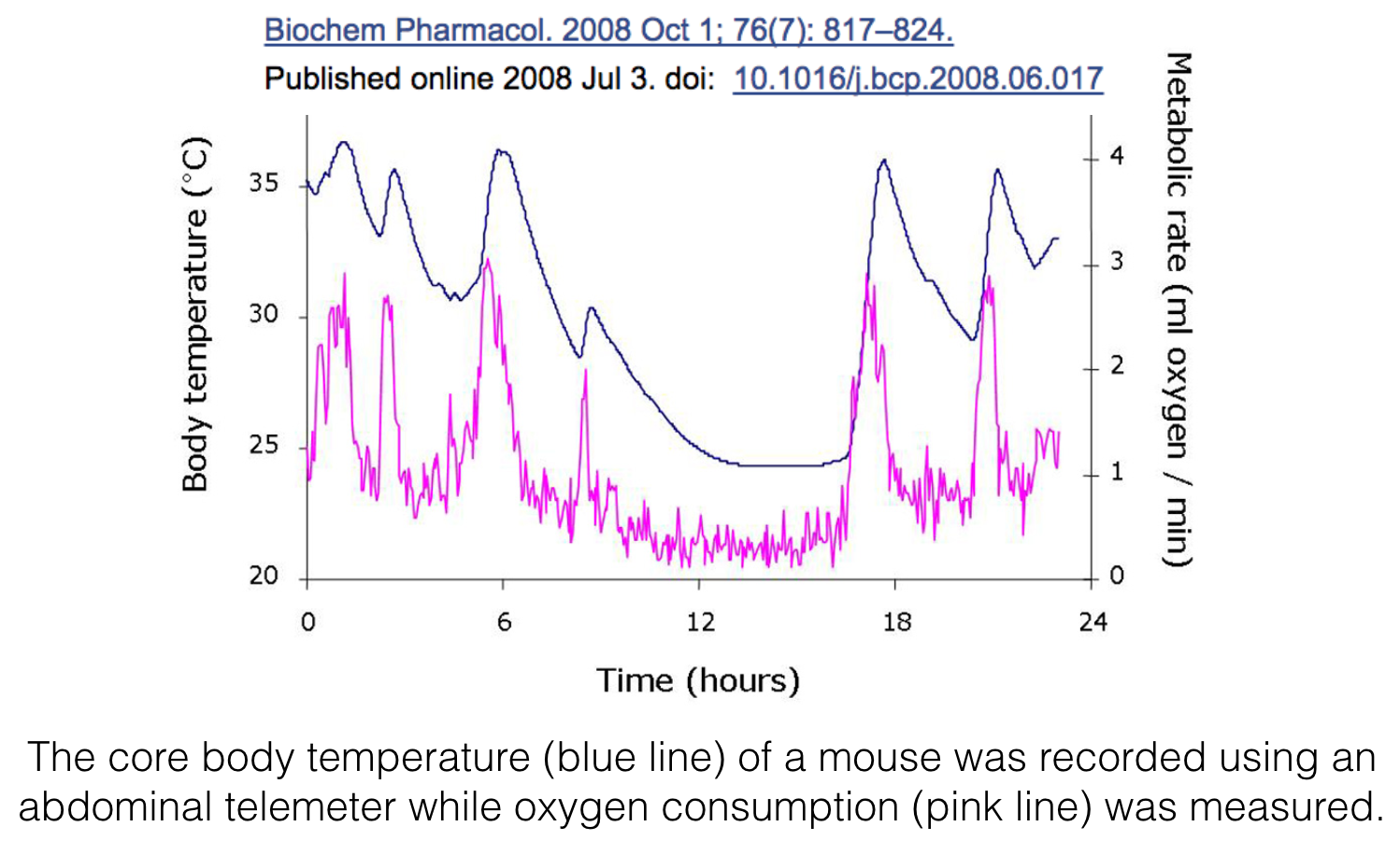The body temperature is not just a good measure of the metabolic rate, it’s an exact measure. A thermometer is literally a speedometer. You’ve noticed that as you start to boil water, the vapor speeds up until eventually, the water begins to boil, and as you heat the water more it reaches a “rapid” boil. That’s because the temperature of the water is proportional to the speed of the molecules. That’s physics. When your body temperature is higher, it means that the molecules in your body are moving faster. Period. The speed of your molecules depends on your metabolic rate. Thus, the temperature is a perfect measure of the metabolic rate.
A group of scientists inserted a thermometer sensor into the abdomen of a mouse and measured its body temperature continuously over a 24 hour period (dark line of readings in the diagram below). At the same time, they measured how much oxygen the mouse consumed out of the air (a difficult but direct measure of the metabolic rate)(red line of readings in the diagram below).
Notice how the two lines of readings are mirror images of one another! The only difference is that the temperature rises shortly after the metabolic rate increases (just as the temperature of the water on your stove rises shortly after you turn up the heat on the burner). It’s obvious from this diagram that no thyroid blood test will ever track the metabolic rate as closely as the body temperature does.
The body temperature does fluctuate some during the day. Body temperatures are normally lower in the morning, higher in the afternoon, and lower again in the evening. So if the temperatures are low during the day when they’re supposed to be at their highest, that’s better evidence that there’s a problem. In 2014 scientists published the following chart (Daniela Grimaldi, Federica Provini; Evidence of a diurnal thermogenic handicap in obesity; Chronobiology International, Early Online: 1–4, (2014)).
They took temperature readings from 9 obese volunteers (black dots) and 12 lean volunteers (white circles) over a 20 hour period. The gray box indicates night time. Notice that the temperatures of the obese volunteers averaged about one degree F less than that of the lean volunteers during the day. Interestingly, their temperatures were almost identical at night. The real difference in temperatures between the obese people and the lean people started several hours after rising and lasted for about 6 hours.
These findings agree with Dr. Wilson’s experience and his recommendation that body temperatures be taken during the day when people are experiencing their symptoms. One approach is for you to take your temperature when you feel your worst and take your temperature when you feel your best and compare the two. With this approach, you will quickly see the correlation between your symptoms and low body temperature. (Information for Physician Training HERE)
Another approach is for you to measure your body temperature
- By mouth with a thermometer
- Every 3 hours
- 3 times a day, starting 3 hours after waking
- For several days (not the 3 days prior to the period in women since its higher then) for diagnosis
- And regularly during treatment
Here is a convenient temperature chart you can print out and use to record your temperatures.
For each day, add the 3 temperatures together and divide by 3 to get the average.
If your temperature consistently averages below 98.6 and you have symptoms of a slow metabolism then you may be suffering from Wilson’s Temperature Syndrome.
Helpful Tips
It’s generally a good idea to warm the thermometer against your neck or abdomen before measuring your temperature (especially in cold weather). A cold thermometer can cool your mouth down a little. The closer it is to body temperature the better (but not above body temperature because that will register on the thermometer).
Moving the thermometer around in the mouth very much can increase blood flow to the area. That increased blood flow is coming from your heart which is one degree warmer and can increase the temperature reading. Therefore, try not to move the thermometer unnecessarily while taking your temperature. Thermometers normally get their readings within 2-5 minutes. However, the temperature can continue to rise when left in longer but that is probably due to the increased blood flow.
Some people have trouble “shaking down” a liquid metal and glass thermometer, in order to reset it for the next reading. One easy way to do this is with the thermometer in its case, slip it into a sock (with the end that goes in your mouth going in first toward the toe of the sock). Then, grab the sock by the ankle and spin it around like a propeller. This action will spin the metal down into the end of the thermometer, like a centrifuge.
Temperature patterns are also important and illuminating. How patients feel can be affected not only by how high or low their temperatures are but also on how steady their temps are. This is especially important during T3 therapy. One temperature reading a day is not enough to see how widely the temperature is fluctuating, but more than three a day can be too time-consuming.
What kind of thermometers should I get?
Digital thermometers are very fast and convenient but can easily become inaccurate from:
- dropping them from 4 inches or more
- low batteries
- exposure to water or humidity
When they become inaccurate they can still give a reading, it just won’t be right. There’s no way of knowing whether the reading is correct or not. Sometimes, a digital thermometer will show one reading one minute and another the next.
Mercury Thermometers are no longer sold in the USA because of environmental concerns. One doctor believes that some mercury can make it through the glass of intact thermometers. She believes that some of her patients who are especially sensitive to mercury have noticed episodes of acute depression, headaches, and malaise just from measuring their temperatures with a mercury thermometer.
We recommend some great new liquid metal thermometers (not mercury). They contain a metal alloy called Galistan. We think they’re better than mercury thermometers ever were. For one thing, they provide accurate readings in only 2 minutes! This is especially true if the thermometer is 72 degrees or warmer before you measure your oral temperature.
If you have a different liquid metal thermometer, you can test it by keeping it in a quart of warm water and measure how long it takes for the temperature reading on the thermometer to stop changing.
Glass Alcohol thermometers are very consistent but frequently don’t hold their readings. They usually contain a red liquid. These thermometers are fine as long as you read them right away.
Thermometer accuracy
No matter what thermometer you choose, no matter how new, it may still not be perfectly accurate. There is always some variation among thermometers, some small, some large. The important thing is for patients to be able to see the changes in their temperatures with proper T3 therapy. Therefore it would make sense for patients to try to take their temperatures, in the same way, each time with the same thermometer for comparison’s sake. The Galistan and Alcohol thermometers are especially good for this since they are so consistent. The liquids they contain are going to expand with warming the same way every time (make sure to shake down the Geratherm Galistan thermometers before each use to reset them). So even if a patient has a Geratherm Galistan or Alcohol thermometer that is a little inaccurate, at least it will be consistently inaccurate and in that way still useful (in showing the improvement in temperature with treatment).
By the same token, if your story is consistent with Wilson’s Temperature Syndrome and you find your temperature is normal, by all means, check it with another two or three thermometers! Many patients have found that their thermometers were wrong and their temperatures were low and they have responded well to treatment. In fact, if your history is classic for Wilsons Temperature Syndrome your chances of having a normal temperature are only about 1 in 200. There’s a lot better chance that your thermometer is wrong than there is that your temperature’s normal.
These issues of thermometer accuracy don’t come up very often but they come up often enough that doctors and patients would be well served to know about them. For the most part, patients are easily able to see that their temperatures are low before treatment, that they come up with treatment, and that their complaints begin to disappear as their temperatures improve.
Your temperature’s low, now what?
You can order your own labs to see if your low temperature is due to Hypothyroidism/Hashimoto’s Thyroiditis or Wilson’s Temperature Syndrome. And you can find a provider that is trained in normalizing low body temperatures to help you recover. Physician training information HERE.



